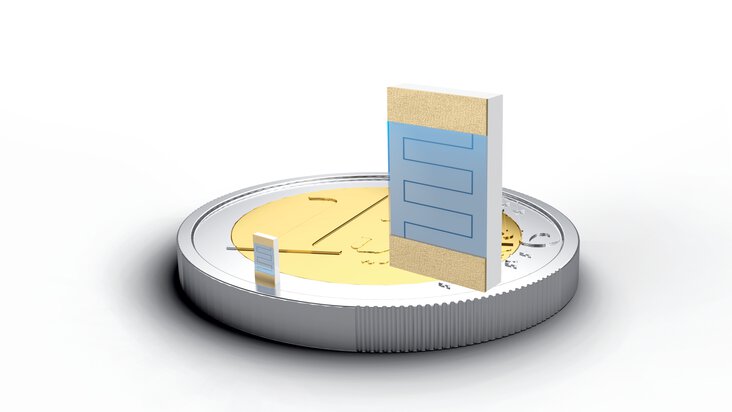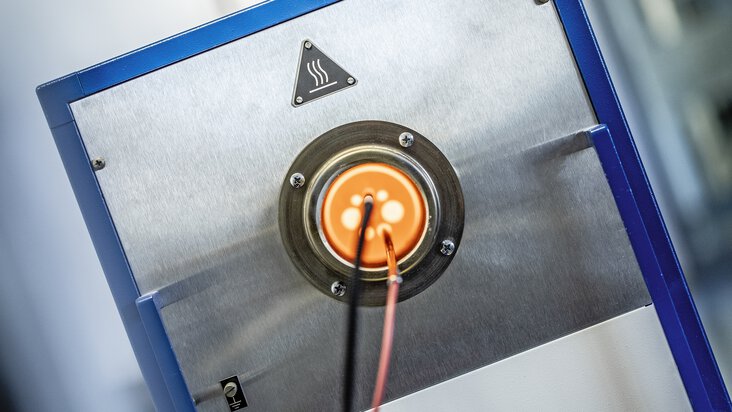
Pt100 – The most important details in a nutshell
The Pt100 plays a major role in industrial temperature measurement of liquids, gases as well as solids and is available in different versions. Learn more about the intelligent temperature sensor, its design, and behavior!
Table of content
What is a Pt100?
A Pt100/Pt 100 is the most frequently used sensor element in industrial thermometers and changes its ohmic resistance depending on the temperature. Connected to an evaluation unit, the sensor temperature can be determined from the measured resistance. The Pt100 is often also referred to as the Pt100 sensor or resistance sensor.
How is a Pt100 constructed?
The Pt100 is usually used as a platinum chip temperature sensor and consists of a ceramic carrier to which a thin platinum layer is applied by a sputtering process. Due to the very thin layer thickness, the term thin film sensors is also commonly used. The platinum coating is then structured in a meandering pattern using a photolithographic process. The connecting wires are welded onto pads and these contact surfaces are strain-relieved with a glass layer. A further - melted - glass layer acts as a cover layer to protect the platinum meanders from external influences and serves as insulation.
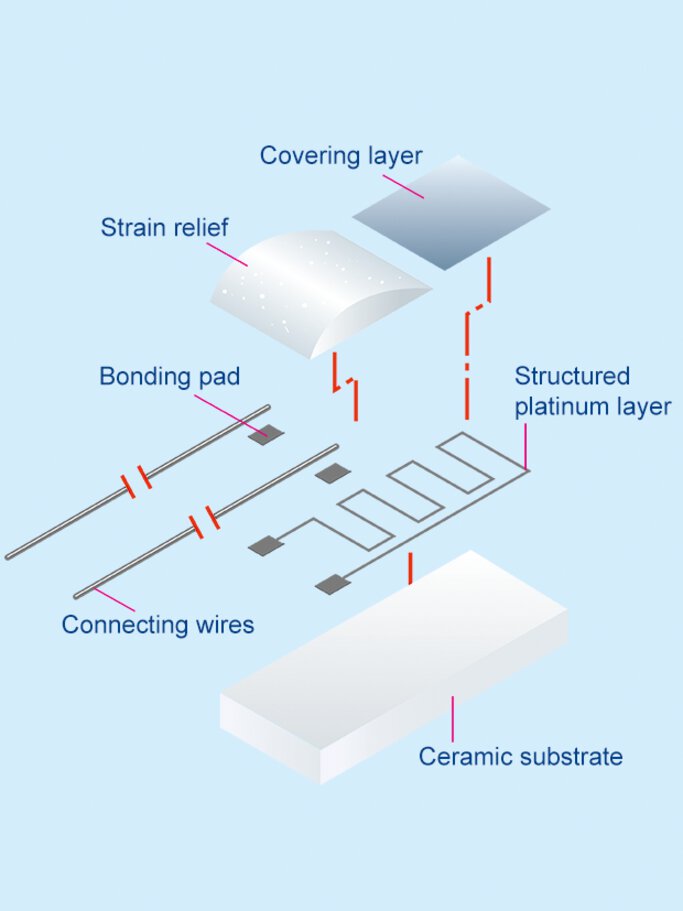
Structure of a Pt100 sensor
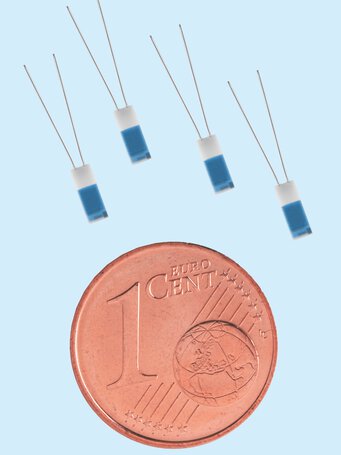
Size comparison of a Pt100 sensor
Where is a Pt100 with connection wires used?
A wired Pt100 is mainly used in industrial electrical temperature measurement in RTD temperature probes.
Furthermore, the thin film sensors are available in Surface Mounted Device design, SMD design for short. These do not have any wire connections, but are soldered directly onto the circuit board via solderable connection caps.
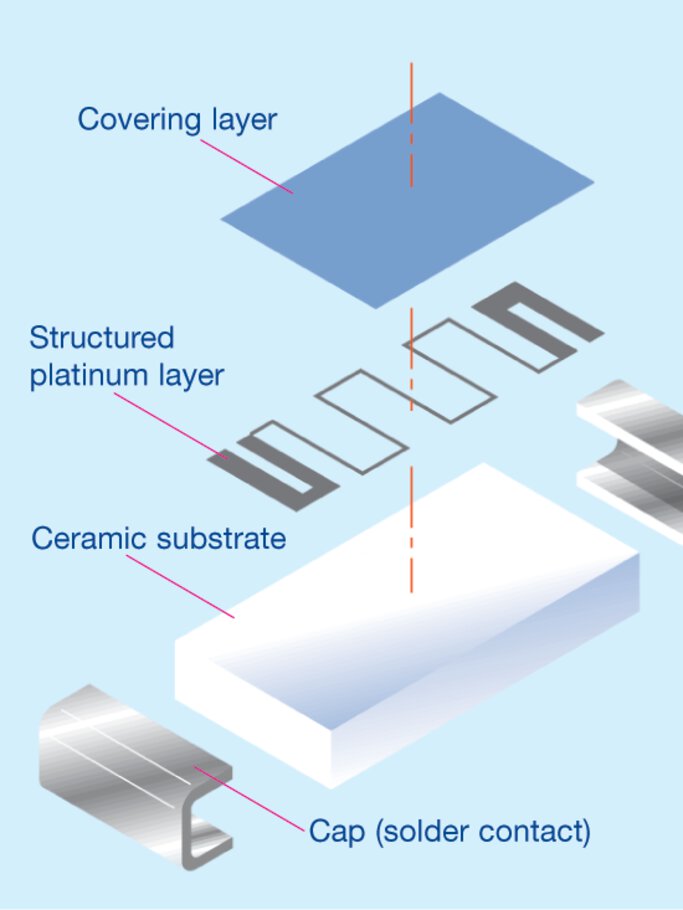
Structure of a Pt100 sensor in SMD design

Size comparison of a Pt100 sensor in SMD design
Where is a Pt100 in SMD design type used?
Pt100 sensors in DMD design type are suitable for surface or ambient temperature measurement on circuit boards and are the preferred choice for temperature monitoring or compensation circuits. In addition, a popular use of SMD sensors is the construction of measuring inserts for temperature probes. A circuit board is automatically equipped with the Pt100 sensors in SMD design type to form a preassembled measuring insert that can be slid into a thermowell. Such probes are used, for example, in large numbers for heat quantity measurement.
What is a wirewound Pt100?
Platinum chip temperature sensors have existed since the 1980s. They largely replaced the Pt100 sensors with a platinum wire winding used until then. The winding of these sensors is either fused into glass (glass sensor) or housed in holes in a ceramic tube (ceramic sensor).
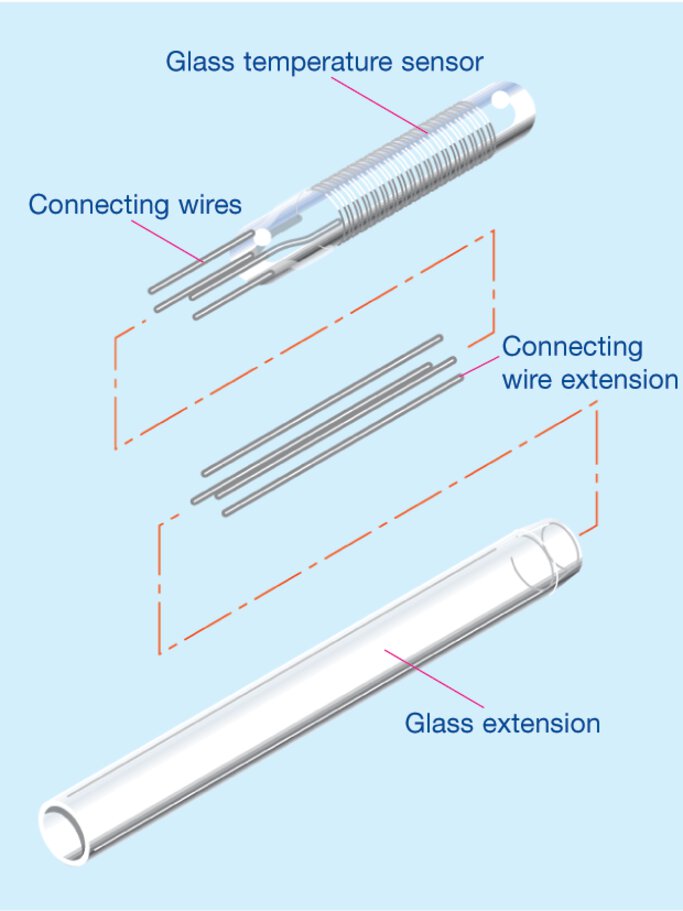
Structure of a glass sensor
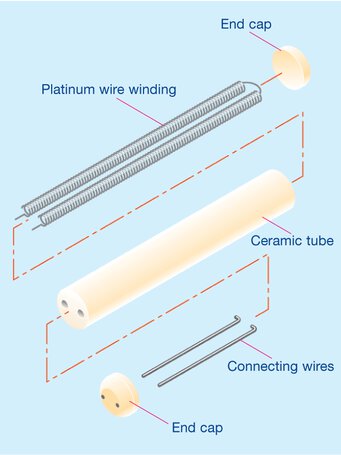
Structure of a ceramic sensor
Where are wirewound Pt100 sensors used?
Measurements of up to 800 °C are possible with these sensors. In special applications, the wire-wound sensors are still used today (for example, in laboratories). However, the platinum chip temperature sensors described above are usually used.
What does Pt100 stand for?
"Pt" is the designation for platinum and the number 100 designates the basic resistance of 100 ohms at 0 °C.
How does a Pt100 work?
At 0 °C, a Pt100 has a basic resistance of 100 Ohm. With increasing temperature, the sensor changes its resistance by about 0.38 ohm/kelvin (i.e. per °C temperature change). The characteristic curve is standardized (DIN EN 60751) and thus evaluation units can determine the sensor temperature from the measured resistance.
For more information on the application of Pt100 sensors in electrical thermometers, watch the video.
What is a Pt100 resistance table?
The behavior of a Pt100 described above can easily be read from a Pt100 resistance table.
Pt100 reference values of the resistor in steps of 1 °C:
|
°C
|
0 |
1 |
2 |
3 |
4 |
5 |
6 |
7 |
8 |
9 |
|
0 |
100.000 |
100.391 |
100.781 |
101.172 |
101.562 |
101.953 |
102.343 |
102.733 |
103.123 |
103.513 |
|
10 |
103.903 |
104.292 |
104.682 |
105.071 |
105.460 |
105.849 |
106.238 |
106.627 |
107.016 |
107.405 |
|
20 |
107.794 |
108.182 |
108.570 |
108.959 |
109.347 |
109.735 |
110.123 |
110.510 |
110.898 |
111.286 |
|
30 |
111.673 |
112.060 |
112.447 |
112.835 |
113.221 |
113.608 |
113.995 |
114.382 |
114.768 |
115.155 |
|
40 |
115.541 |
115.927 |
116.313 |
116.699 |
117.085 |
117.470 |
1178.56 |
118.241 |
118.627 |
119.012 |
|
50 |
119.397 |
119.782 |
120.167 |
120.552 |
120.936 |
121.321 |
121.705 |
122.090 |
122.474 |
122.858 |
|
60 |
123.242 |
123.626 |
124.009 |
124.393 |
124.777 |
125.160 |
125.543 |
125.926 |
126.309 |
126.692 |
|
70 |
127.075 |
127.458 |
127.840 |
128.223 |
128.605 |
128.987 |
129.370 |
129.752 |
130.133 |
130.515 |
|
80 |
130.897 |
131.278 |
131.660 |
132.041 |
132.422 |
132.803 |
133.184 |
133.565 |
133.946 |
134.326 |
|
90 |
134.707 |
135.087 |
135.468 |
135.848 |
136.228 |
136.608 |
136.987 |
137.367 |
137.747 |
138.126 |
|
100 |
138.506 |
138.885 |
139.264 |
139.643 |
140.022 |
140.400 |
140.779 |
141.158 |
141.536 |
141.914 |
What does the Pt100 formula say?
For metallic temperature sensors a polynomial can be used to calculate which sensor resistance results for different sensor temperatures.
The basic formula for the second order polynomial is:
R(T) = R0 x (1 + A x ϑ + B x ϑ2)
R0: Basic resistance at 0 °C
ϑ: Temperature in °C
A, B: Individual coefficients of the sensor
For a Pt100, the base resistance is 100 Ω and the coefficients are 3.9083 ×10-3 °C-1 (A) and -5.775 ×10-7 °C-2(B). Substituted into the polynomial, the Pt 100 formula is:
R(T) = 100 Ω x (1 + 3.9083 ×10-3 °C-1 x ϑ - 5.775 ×10-7 °C-2x ϑ2)
The formula is valid for positive temperatures.
Are there other nominal resistors?
Platinum sensors also exist with basic resistances such as 1000 ohms (at 0 °C). Other nominal resistances are also producible, but rare.
For which temperatures is a Pt100 suitable?
The thin film technology allows measurements in a range from -70 to +600 °C.
What about the Pt100 accuracy?
The tolerances are also specified in the standard. For the thin-film resistors, there are tolerance classes or Pt100 accuracy classes from F 0.1 (high accuracy) to F 0.6 (low accuracy). The tolerance or limit deviation is determined according to the standard by inserting the measuring temperature into the respective formula.
| Pt100 accuracy classes | |
|---|---|
| Tolerance classes | Boundary deviation [K] |
| F 0,1 | ±(0,1 + 0,0017 x ItI) |
| F 0,15 | ±(0,15 + 0,002 x ItI) |
| F 0,3 | ±(0,3 + 0,005 x ItI) |
| F 0,6 | ±(0,6 + 0,01 x ItI) |
Here are two examples:
Determination of the tolerance for a sensor of class F 0,1 and a measuring temperature of 100 °C:
±(0,1+0,0017 x I100I= ± 0,27 K (corresponds to ±0,27 °C)
Determination of the tolerance for a sensor of class F 0,3 and a measuring temperature of 400 °C:
±(0,3+0,005 x I400I= ± 2,3 K (corresponds to ±2,3 °C)
What are the advantages of a Pt100?
Pt100 sensors are very stable in the long term, which is mainly explained by the resistance material platinum. The characteristic curve of the sensors is standardized. If the characteristic curve is available in an evaluation unit, the evaluation of the temperature signal is possible. Due to the standardization, the procurement of spare parts for the sensors or assembled thermometers is very unproblematic.
- ${title}${badge}
